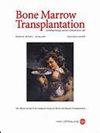干细胞动员能力差的多发性骨髓瘤患者第二次自体造血细胞移植后的满意疗效:代表 EBMT 慢性恶性肿瘤工作组进行的回顾性研究。
IF 4.5
2区 医学
Q1 HEMATOLOGY
引用次数: 0
摘要
自体造血细胞移植(auto-HCT)仍然是符合移植条件的 MM 患者的标准治疗方法。一般的做法是在诱导后先行无细胞抽吸,以收集足够数量的 CD34+ 细胞,从而进行两次自身造血干细胞移植。然而,5%-30%的MM患者最初无法动员足够数量的造血干细胞,被归类为动员不良者(PM)。我们比较了61名PM患者和816名非PM患者的基线特征和预后,这些患者接受了第二次自身造血干细胞移植,并参加了非干预性CALM研究(NCT01362972)。只有在自体血细胞移植1之前采集了CD34+的患者才被纳入研究。自体血细胞移植2包括串联移植和挽救性移植。用普乐沙福(24人,占39.3%)或非普乐沙福方案(37人,占60.7%)重新动员PM。PM患者和非PM患者在第二次自动血液透析后的移植、无进展生存期(PFS)或总生存期(OS)方面没有明显差异。接受抢救性自体血细胞移植的原发性骨髓瘤患者的PFS有缩短的趋势(中位9.6个月对12.9个月;P = 0.08),但OS无明显差异。PM患者的中位OS为41.1个月,非PM患者为41.2个月(P = 0.86)。这些数据表明,抢救性动员是有效的,不会影响第二次自体血细胞移植后的总体疗效。本文章由计算机程序翻译,如有差异,请以英文原文为准。

Satisfactory outcomes following a second autologous hematopoietic cell transplantation for multiple myeloma in poor stem cell mobilizers: a retrospective study on behalf of the Chronic Malignancies Working Party of the EBMT
Autologous hematopoietic cell transplants (auto-HCTs) remain the standard of care for transplant-eligible MM patients. The general practice has been to undergo upfront apheresis following induction to collect sufficient number of CD34+ cells to facilitate two auto-HCTs. However, 5–30% of MM patients do not initially mobilise a sufficient number of hematopoietic stem cells and are classified as poor mobilizers (PM). We compared the baseline characteristics and outcomes of 61 PMs and 816 non-PM patients who underwent a second auto-HCT and who were enrolled in the non-interventional CALM study (NCT01362972). Only patients who collected CD34+ prior to auto-HCT1 were included. Auto-HCT2 comprised both tandem and salvage transplants. PMs were re-mobilized with plerixafor (n = 24, 39.3%) or non-plerixafor-based regimens (n = 37, 60.7%). There were no significant differences in engraftment, progression-free survival (PFS) or overall survival (OS) after the second auto-HCT between PM and non-PM patients. There was a trend to shorter PFS in PM patients undergoing salvage auto-HCT (median 9.6 vs. 12.9 months; p = 0.08) but no significant difference in OS. The median OS was 41.1 months for PM and 41.2 months for non-PM patients (p = 0.86). These data suggest that salvage mobilization is effective and does not affect overall outcomes after a second auto-HCT.
求助全文
通过发布文献求助,成功后即可免费获取论文全文。
去求助
来源期刊

Bone Marrow Transplantation
医学-免疫学
CiteScore
8.40
自引率
8.30%
发文量
337
审稿时长
6 months
期刊介绍:
Bone Marrow Transplantation publishes high quality, peer reviewed original research that addresses all aspects of basic biology and clinical use of haemopoietic stem cell transplantation.
The broad scope of the journal thus encompasses topics such as stem cell biology, e.g., kinetics and cytokine control, transplantation immunology e.g., HLA and matching techniques, translational research, and clinical results of specific transplant protocols. Bone Marrow Transplantation publishes 24 issues a year.
 求助内容:
求助内容: 应助结果提醒方式:
应助结果提醒方式:


